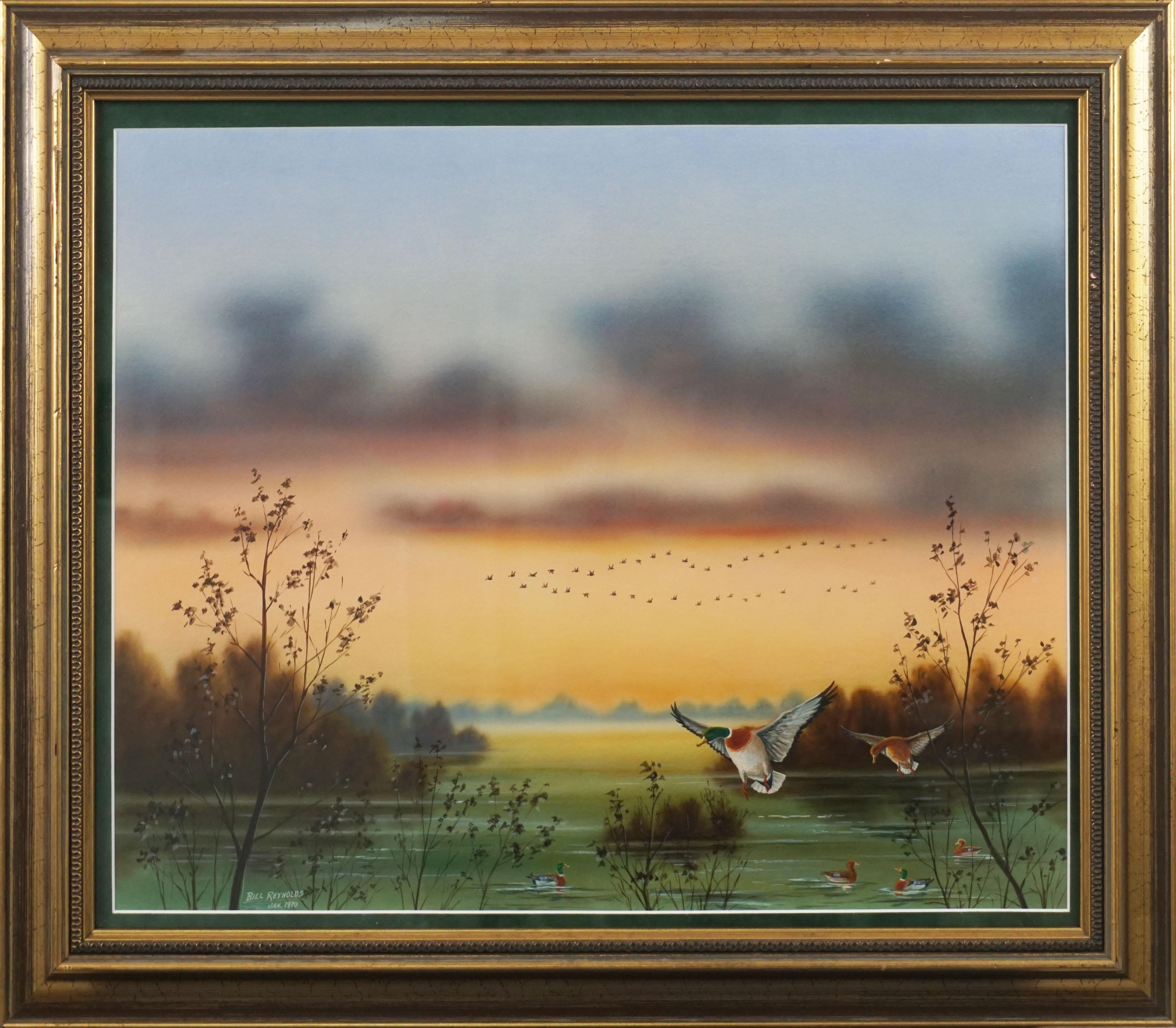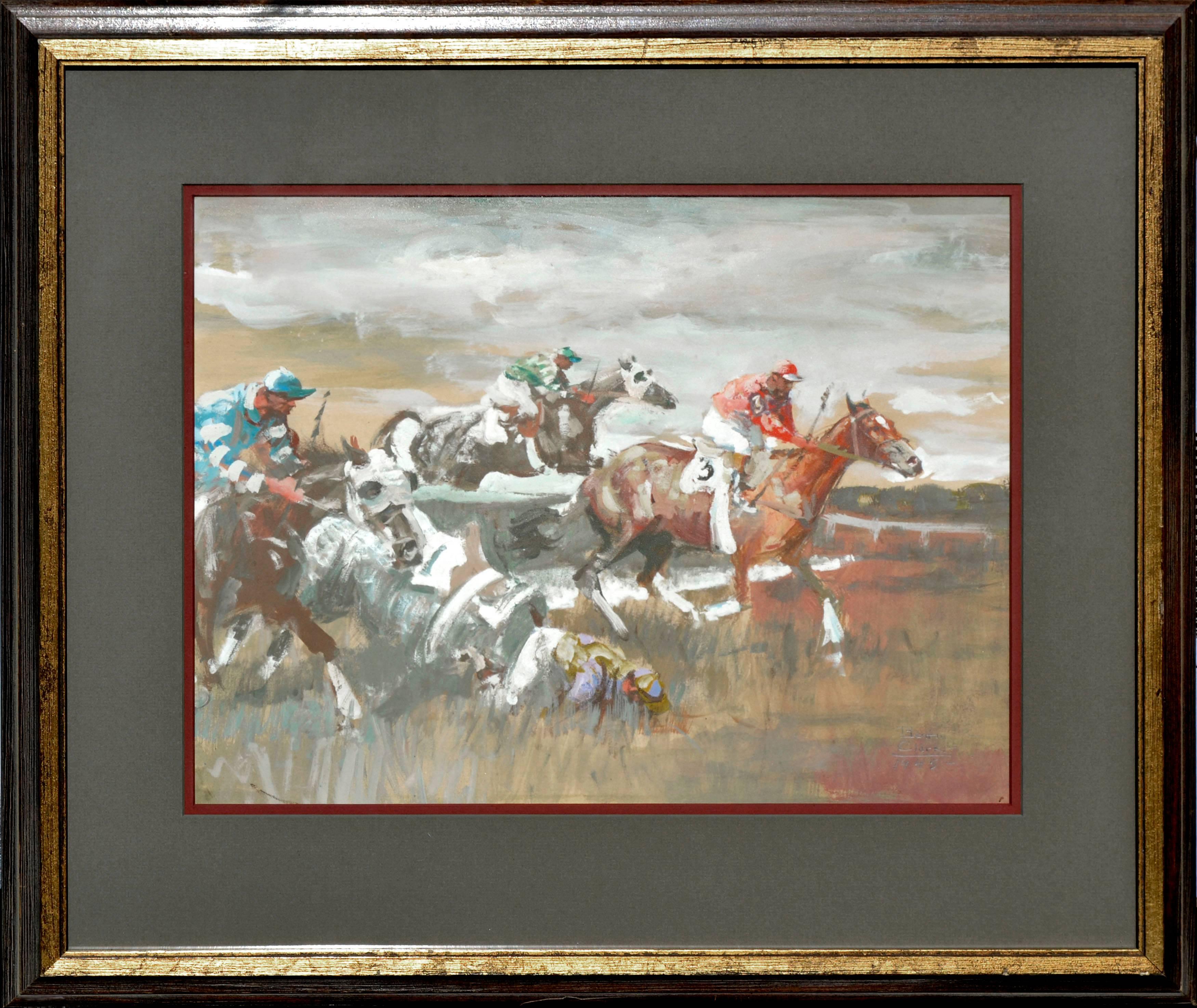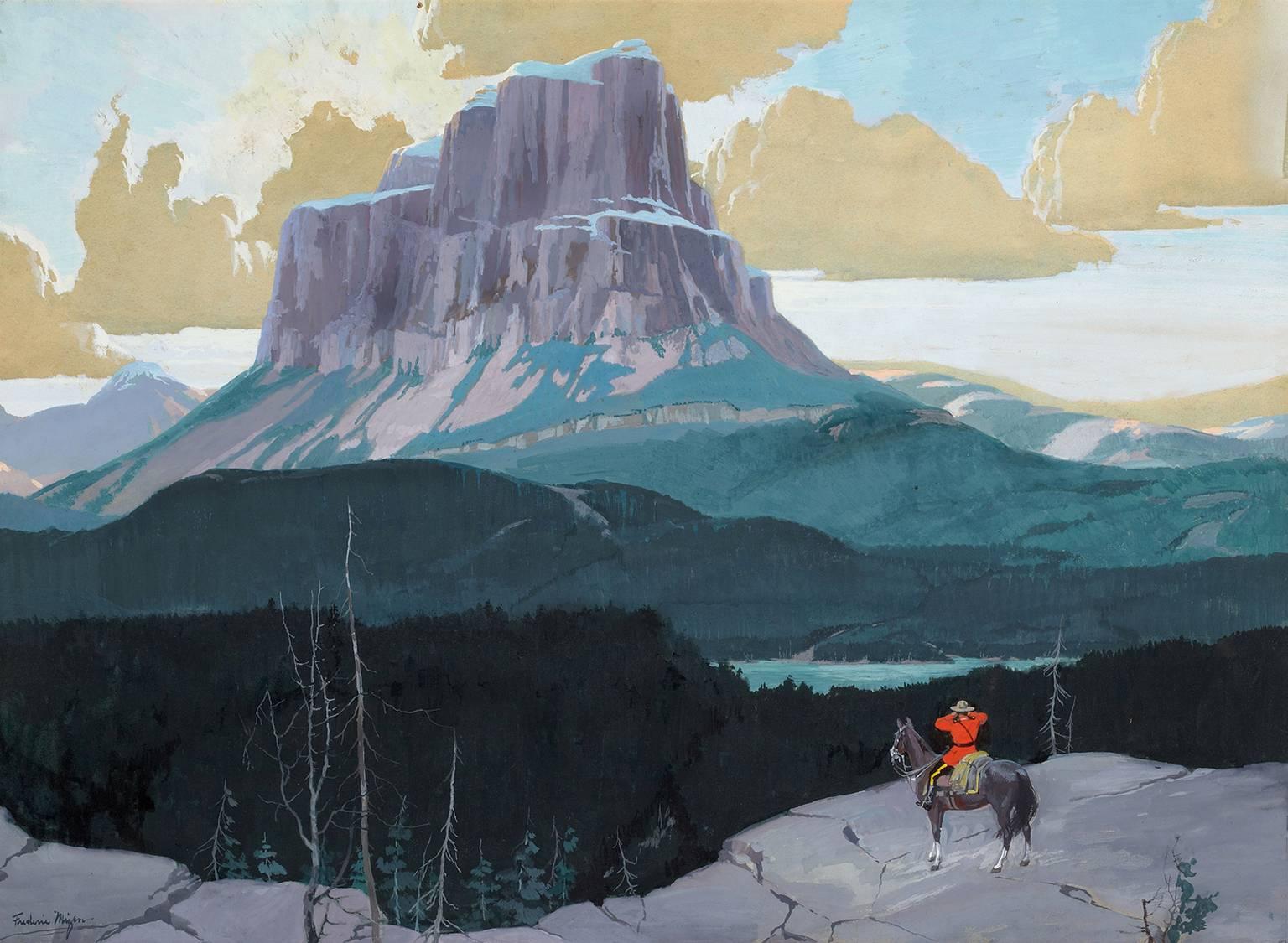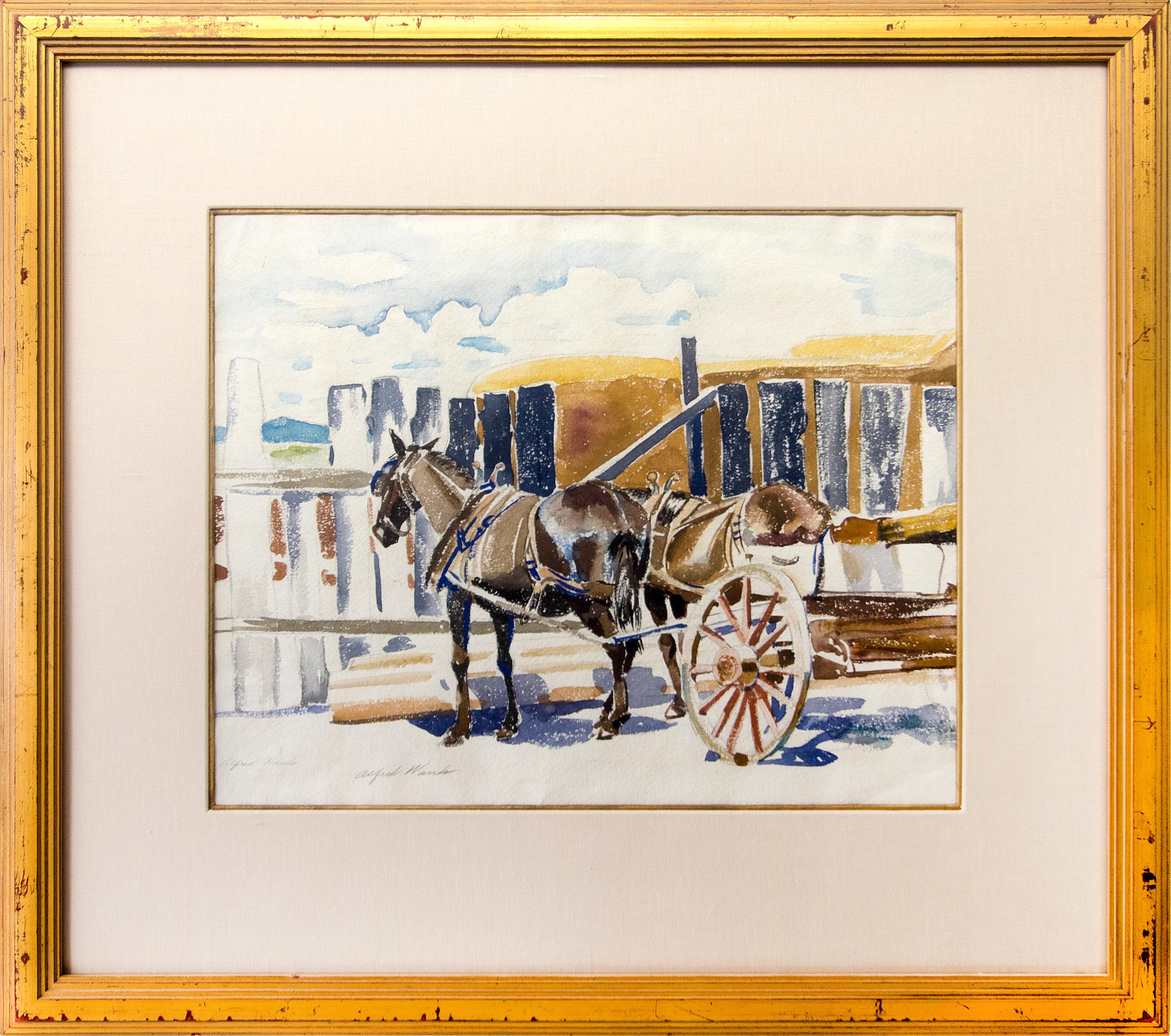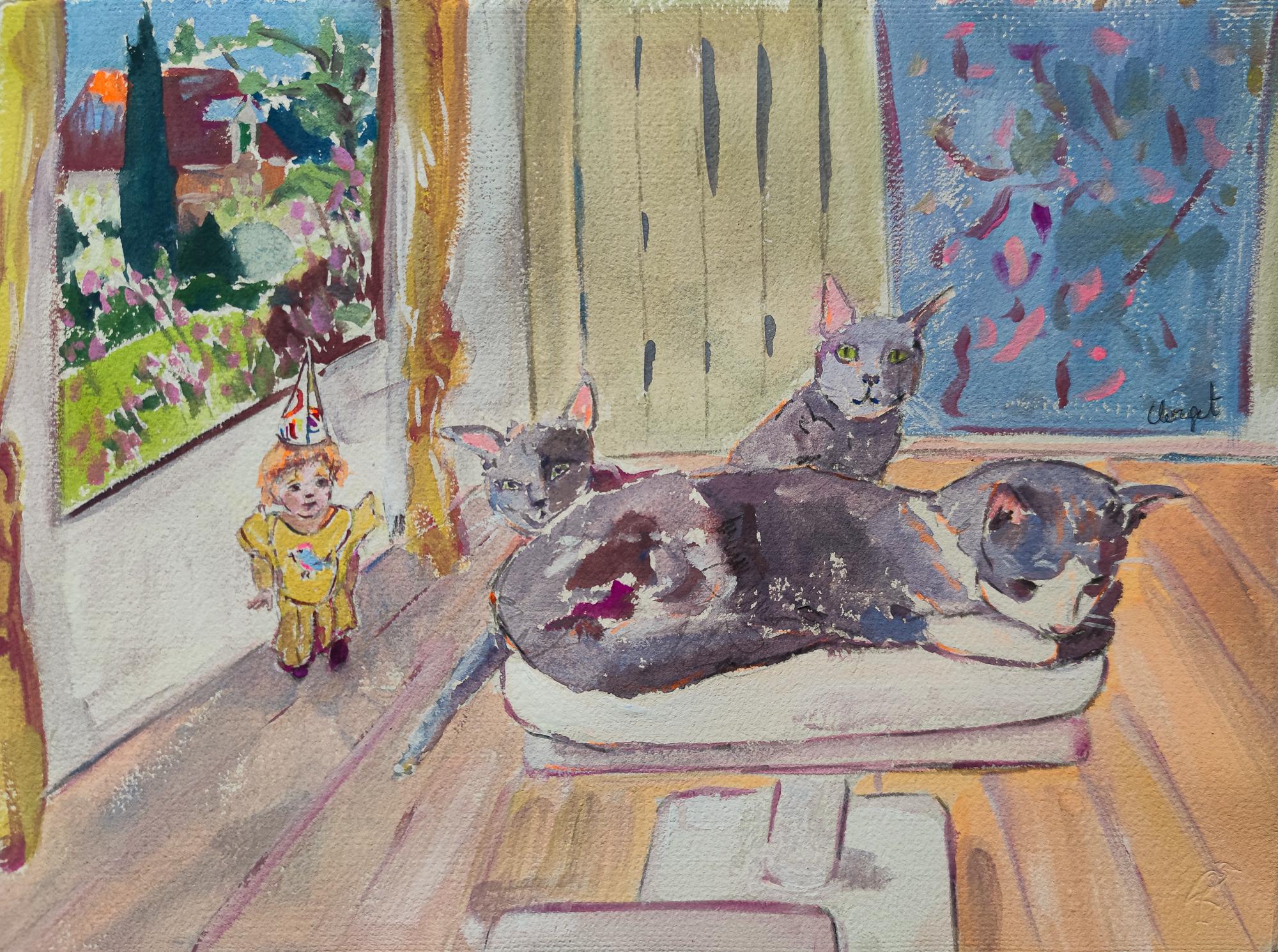Items Similar to Rodeo. Bareback Bronco. Mid 20th Century. 1966. Western Cowboy Ranch Equestrian.
Want more images or videos?
Request additional images or videos from the seller
1 of 24
John Rattenbury SkeapingRodeo. Bareback Bronco. Mid 20th Century. 1966. Western Cowboy Ranch Equestrian.1966
1966
About the Item
John Rattenbury Skeaping.
English ( b.1901 - d.1980 ).
Rodeo. Bareback Bronco,1966.
Gouache on Paper. Signed and dated.
Image size 21.3 inches x 29.1 inches ( 54cm x 74cm ).
Frame size 28.5 inches x 36.4 inches ( 72.5cm x 92.5cm ).
Available for sale; this original gouache on Arches paper painting is by John Rattenbury Skeaping and is dated 1966.
The painting is presented and supplied in a new contemporary frame (which is shown in these photographs), a new mount, conservation materials and non-reflective Tru Vue UltraVue® UV70 glass. This piece is in superb condition. It wants for nothing and is supplied ready to hang and display.
The painting is signed and dated lower right.
John Skeaping is regarded as the leading equine sculptor of the twentieth century. He also became a highly regarded racehorse painter in his middle age.
He was born in South Woodford, Essex, England on 9 June 1901. His father was a portrait painter who shared a studio with Cézanne and his mother was a musician. Several other members of his family were also very artistic. He had an unconventional childhood as one of four children, none of whom were sent to school. His father believed in a basic training in the arts and they were therefore taken to exhibitions, concerts, theatre and ballet. For young John, the tandem themes of horses and art emerged and remained with him for the rest of his life.
Aged 13 John Skeaping was already showing an early aptitude, and enrolled at Blackheath School of Art. Then aged 14 he went to Goldsmiths College in the Sculpture School. From there he went to the Central School of Arts & Crafts and then the Royal Academy Schools, where he won the Royal Academy Gold Medal and travelling scholarship. He then taught in Newcastle.
In 1924 he won the Prix de Rome and went to Rome on a three year scholarship. Barbara Hepworth won the second prize and they met in Rome and married in Florence in 1925. They returned to London in 1926 and worked together for a while. Indeed, they put on a joint exhibition in Glasgow and London in 1928 that established them in the forefront of British Sculpture. However, the couple drifted apart artistically and personally and separated in 1931, divorcing two years later.
Skeaping continued modeling and carving, and created several animal pieces for Wedgwood in 1928 of a Sea Lion, Kangaroo, Duiker, Polar Bear, Bison, Tiger, Deer and Antelope groups that are quite stylized and reflect the Art Deco influence of the era. He also did stone carvings of animals during this time.
During the 1930s, Skeaping spent as much time as possible in the countryside with his second wife, whom he married in 1934. They were lent a cottage in Dartmoor, where they stayed for a summer and started to train and race greyhounds.
At the beginning of the Second World War Skeaping served in the Royal Intelligence Corps as an official war artist in Europe before transferring to the SAS in North Africa. However, he began to suffer from nervous stomach trouble and was invalided out just before the end of the war. On his return to civilian life he became disillusioned with London, so went to Devon to live. After a short while though he returned to London and spent a period teaching at the Royal College of Art. He then went to Mexico for a year and a half, living amongst the Native Americans and learning how to make their traditional pottery.
In 1950 he returned to England and became Professor of Sculpture at the Royal College of Art. He remained there until his retirement in 1959 when he moved to the Camargue in France, partly for health reasons. There he studied the wild horses of the Carmargue and lived for twenty years with his third wife.
Skeaping first exhibited at the Royal Academy in 1922; he was elected an Associate there in 1951 and Academician in 1959.
During the late 1940s and into the 1950s, Skeaping was associated with the famous Ackermann firm who offered sporting and racing art. He produced many paintings and drawings of horses during this time. Most of his equestrian works are from the 1960s and 1970s and his subjects covered racehorses, harness horses, flat racers and steeplechasers. He also did some fine commissioned portraits of famous horses of the day including Triple Crown winner Secretariat, Hyperion, Mill Reef, Brigadier Gerard, Chamossaire, and more. He received many commissions during his life, mainly for his horse sculptures.
Between 1960 and 1969, seven of his one man shows were held at Ackermann’s Gallery, and there were retrospective exhibitions at the same venue in 1979, 1981 and 1984. He wrote and illustrated four books, including his autobiography Drawn from Life, which was published in 1977. He died in London on 5 March 1980.
Today John Skeaping’s sculpture and paintings are in many museum collections, including the Tate, the British Museum, and the Royal Academy in the UK, and others in the USA, Japan, and Australia, as well as in private collections. His bronzes were cast in small editions of 10 or less casts, and are very highly prized.
© Big Sky Fine Art
This original gouache on paper painting depicts a typical American western rodeo scene. Around the edge of the arena are brightly painted fences and above the ring is a large sign, on which is painted “Rodeo”. In the ring there is a bay horse, bucking and trying to dislodge its rider. The rider is hanging on and seems to know what he is doing! He is wearing a long-sleeved white shirt, a black Stetson and cowboy boots and cream riding trousers. In the background are the vague figures of several other cowboys, watching the entertainment. There is a great energy in this piece, and it is a spirited record of social history.
- Creator:John Rattenbury Skeaping (English)
- Creation Year:1966
- Dimensions:Height: 28.55 in (72.5 cm)Width: 36.42 in (92.5 cm)Depth: 0.79 in (2 cm)
- Medium:
- Movement & Style:
- Period:
- Condition:This vintage painting is in very good condition, commensurate with its age. It wants for nothing and is supplied ready to hang and display.
- Gallery Location:Sutton Poyntz, GB
- Reference Number:1stDibs: LU489314149632
About the Seller
5.0
Gold Seller
These expertly vetted sellers are highly rated and consistently exceed customer expectations.
Established in 2010
1stDibs seller since 2016
110 sales on 1stDibs
Typical response time: 1 hour
- ShippingRetrieving quote...Ships From: Sutton Poyntz, United Kingdom
- Return PolicyA return for this item may be initiated within 14 days of delivery.
More From This SellerView All
- Grey Mare with Foal. Modern British Equestrian Artist. Original Horse Painting.By Neil CawthorneLocated in Sutton Poyntz, DorsetNeil Cawthorne. English ( b.1936 - d.2022 ). Mare with Foal, 1970. Oil on Canvas. Signed and Dated. Image size 17.3 inches x 21.7 inches ( 44cm x 55cm ). Frame size 21.3 inches x 25...Category
Mid-20th Century Impressionist Animal Paintings
MaterialsCanvas, Oil
- Dartmoor Ponies. Early Morning Mist and Haze. Devon Moor Pony.1930s.Wild HorsesBy Charles Walter SimpsonLocated in Sutton Poyntz, DorsetCharles Walter Simpson. English ( b.1885 - d.1971 ). Dartmoor Ponies, Devon. Oil on Board. Signed lower right. Image size 20.7 inches x 28.2 inches ( 52.5cm x 71.5cm ). Frame size 29...Category
1930s Impressionist Animal Paintings
MaterialsOil
- Dame Elisabeth Frink. Hawk, 1969. Watercolor. A Representation of Destruction.By Elisabeth FrinkLocated in Sutton Poyntz, DorsetDame Elisabeth Frink. English ( b.1930 - d.1993 ). Hawk, 1969. Watercolor. Image size 25.4 inches x 19.5 inches ( 64.5cm x 49.5cm ). Frame size 34.4 inches x 28.1 inches ( 87.5cm x 71.5cm ). Available for sale; this original painting is by Dame Elisabeth Frink and is dated 1969. The painting is presented and supplied in a glazed frame and mount dating from June 1997. This vintage watercolor is in very good condition, commensurate with its age. The watercolor is signed and dated lower right. Previously with Beaux Arts, London and Bath in 1999. Dame Elisabeth Frink was one of Britain’s most important post-war sculptors, an accomplished draughtsman, illustrator and teacher. She was part of the post-war school of expressionist British sculptors dubbed the Geometry of Fear, and enjoyed a highly acclaimed career that was commercially successful, broke boundaries and contributed greatly to bringing wonderful sculpture to public places. She was born on 14 November 1930 in Thurlow, the daughter of a cavalry officer, and brought up in rural Suffolk near to an active airbase. She was brought up a Catholic and educated at the Convent of the Holy Family, Exmouth. She then studied at the Guildford School of Art from 1947-1949 under Willi Soukop and Henry Moore’s assistant, Bernard Meadows, and then at the Chelsea School in London 1949-1953. She taught at Chelsea School of Art 1951-61, St. Martin’s School of Art 1954-62 and was a visiting instructor at the Royal College of Art 1965-1967, after which she lived in France until 1973. Frink first came to the attention of the public in 1951 at an exhibition at the Beaux Arts Gallery, London. In 1952 she represented Britain at the Venice Biennale, being described by Herbert Read as “the most vital, the most brilliant and the most promising of the whole Biennale”. The same year the Tate bought its first work by her, and she began to enjoy commercial success. Thereafter she exhibited regularly and was for 27 years associated with Waddington’s, London. The subjects which Frink was most concerned with were man, dog and horses, with and without riders. Interestingly she seldom sculpted the female form, drawing on archetypes of masculine strength, struggle and aggression. Her work has the recurring themes of the vulnerable and the predatory, in the spirit of an authentic post-war artist. It has been said that she was more concerned with representing mankind that portraits of individuals. The appeal of her work lies in its directness, provoking a frank statement of feeling. The anatomy is often exaggerated or incorrect; the impact growing more out of her interest in the spirit of the subject. Her animals and birds may be drawn from nature but verge on the abstract, conveying raw emotion and character rather than a realistic depiction. Her unique style is characterised by a rough treatment of the surface which embeds each piece with vitality and her personal impression. In her later work even the distinction between human and bird figures becomes blurred. Commentators have noted that the often rugged, brutal and contorted surfaces of her work reflect the destruction and terror of the six-year world-wide conflict that she witnessed as a child. Frink was an active supporter of Amnesty International. In the 1960s and early 1970s Frink produced a notable series of falling figures and winged men. Later, living in France during the Algerian war, she began making heads, blinded by goggles which had a threatening facelessness. Frink produced many notable public commissions, including Wild Boar for Harlow New Town, Blind Beggar and Dog for Bethnal Green, Noble Horse and Rider for Piccadilly, London, a lectern for Coventry Cathedral, Shepherd for Paternoster Square beside St. Paul’s Cathedral and a Walking Madonna for Salisbury Cathedral. In the early 1980s she produced a set of three larger than life figures The Dorset Martyrs which stand on the edge of the old walled town of Dorchester on the site of the old gallows, as a memorial to those who had been executed there ‘for conscience sake’. Frink’s Canterbury Tales was a collection of 19 etchings drawn directly on to copper plates and etched by her. The ‘book’ was issued in three limited editions. Her illustrations have been praised as “amongst the most successful illustrations of the century, encompassing the mood of the text in concise delineations and disarmingly ribald humour”. She illustrated other books with colored lithographs or drawings. Frink was on the Board of Trustees, British Museum from 1976, and was a member of the Royal Fine Art Commission 1976-81. CBR (1969), DBE ((1982), Associate of the Royal Academy (1971), Royal Academy (1977). She was made a Companion of Honour in 1992. She died on 18 April 1993, but not before completing her last commission, a monumental but unusual figure of Christ for the front of the Anglican Cathedral in Liverpool, unveiled a week before her death. For several decades Frink exhibited widely in the UK and abroad. In her later years she lived and worked in Dorset where her home and garden became an arena for her work. In 1985 she had a retrospective at the Royal Academy. She died on 18 April 1993, but not before completing her last commission, a monumental but unusual figure of Christ for the front of the Anglican Cathedral in Liverpool, unveiled a week before her death. There was a memorial show at Yorkshire Sculpture Park, Bretton Hall in 1994. Today Frink is venerated as one of the great twentieth century British sculptors. Her unique work is represented in the Tate Gallery and major public and private collections world-wide. © Big Sky Fine Art This original watercolor on paper painting of a hawk by Dame Elizabeth Frink...Category
Mid-20th Century Modern Animal Paintings
MaterialsPaper, Watercolor
- Ponies at Penlan, 1967.Swansea.Wales.Welsh Pony.Valleys.Equestrian.Hot Sun.Located in Sutton Poyntz, DorsetHazel M. Barnett. British. Ponies at Penlan, Swansea, Wales.1967 Oil on Board. Signed. Image size 17.9 inches x 35.6 inches ( 45.5cm x 90.5cm ). Frame size 19.7 inches x 37.4 inches...Category
Mid-20th Century Modern Animal Paintings
MaterialsOil, Board
- Cock Fight. Two Fighting Birds. A Riot of Aggression, Masculinity & FeathersBy David WildeLocated in Sutton Poyntz, DorsetDavid Wilde. English ( b.1913 - d.1974 ). Cock Fight. Acrylics. Signed and Titled. Image size 15.4 inches x 22.2 inches ( 39cm x 56.5cm ). Frame size 19.1 inches x 26 inches ( 48.5c...Category
Mid-20th Century Surrealist Animal Paintings
MaterialsAcrylic
- Milly with Minstrel. Children with their Pony in Dappled Summer Sunlight.Located in Sutton Poyntz, DorsetHarold Walton Freckleton. English ( b.1890 - d.1979 ). Milly with Minstrel. Oil on Canvas. Signed lower right. Image size 24.4 inches x 29.52 inches ( 62cm x 75cm ). Frame size 30.7 ...Category
Mid-20th Century Realist Animal Paintings
MaterialsCanvas, Oil
You May Also Like
- Breath of Dawn, 1970's Sunrise Lake LandscapeLocated in Soquel, CAGorgeous watercolor/gouache painting of a family of ducks swimming in a lake at dawn by Bill Reynolds (American, 1918-2008), 1970. The foreground is...Category
1970s American Impressionist Landscape Paintings
MaterialsWatercolor, Gouache, Paper
- The Steeple Chase figurativeBy Benton ClarkLocated in Soquel, CAA vintage, dramatic scene of the rigorous sport of steeplechasing by artist Benton Henderson Clark (American, 1895-1964). Signed and dated lower right "Benton Clark 1945." Presented ...Category
1940s American Impressionist Animal Paintings
MaterialsPaper, Gouache
- CanadianMountie Gazing at ButteBy Frederic Kimball MizenLocated in Miami, FLA majestic Canadian mountain rises to the sky with a small Canadian Mountie on hours viewing the scene, Mizen uses a creative technique of exposing...Category
1920s American Impressionist Landscape Paintings
MaterialsGouache, Fiberboard
- Watercolor Painting, Horses, Carriage, Buildings in Blue, Yellow and BrownBy Alfred WandsLocated in Denver, COVintage original modernist watercolor painting of horses attached to a carriage and buildings by Alfred Wands (1904-1998). It is painted in blues, yellows, and browns. Presented in a...Category
20th Century American Impressionist Animal Paintings
MaterialsPaper, Watercolor
- White Cat & Morning Glories, 23x18" watercolorBy Lu HaskewLocated in Loveland, COWhite Cat and Morning Glories by Lu Haskew Watercolor Painting 24x18" image size 30x25" framed (behind glass) Shipping price includes the custom packing necessary for safe transport of fine art. ABOUT THE ARTIST: Lu Haskew 1921-2009 "Life is good to me. Being able to go to my studio five days weekly and paint for several hours, living in a supportive community, having family and friends who encourage me--all have contributed to helping me become an artist. Being fortunate to study with some of the artists I admire has kept me painting from the garden, people and my favorite things. With the support of galleries, teaching and doing demos, how could I do anything else? My goal is to try to be the best I can be by always being a student, looking for new ideas and stretching my horizons." Upon retirement from a 33-year teaching career, Lu rented a studio in Loveland and began concentrating on her oil and watercolor painting. Learning from artists she had followed and admired throughout the years her painting became a full time career that lasted 17-years. Beginning in 1992, she studied with renowned painters Richard Schmid, Clyde Aspevig, Joyce Pike...Category
Early 2000s American Impressionist Animal Paintings
MaterialsWatercolor
- French Impressionist gouache painting "Three Little Cats in My Home"Located in THOMERY, FRCapturant la chaleur et la joie de la vie à la maison, 'Trois petits chats chez moi' est un portrait tendre de mon intérieur douillet. Dans cette œuvre, ma fille de 2 ans porte un ch...Category
21st Century and Contemporary Impressionist Animal Paintings
MaterialsGouache, Handmade Paper
